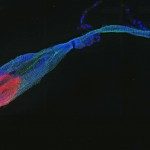Link to Pubmed [PMID] – 9420253
J. Virol. 1998 Jan;72(1):512-9
Human immunodeficiency virus type 1 (HIV-1) entry into target cells is a multistep process initiated by envelope protein gp120 binding to cell surface CD4. The conformational changes induced by this interaction likely favor a second-step interaction between gp120 and a coreceptor such as CXCR4 or CCR5. Here, we report a spontaneous and stable CD4-independent entry phenotype for the HIV-1 NDK isolate. This mutant strain, which emerged from a population of chronically infected CD4-positive CEM cells, can replicate in CD4-negative human cell lines. The presence of CXCR4 alone renders cells susceptible to infection by the mutant NDK, and infection can be blocked by the CXCR4 natural ligand SDF-1. Furthermore, we have correlated the CD4-independent phenotype with seven mutations in the C2 and C3 regions and the V3 loop. We propose that the mutant gp120 spontaneously acquires a conformation allowing it to interact directly with CXCR4. This virus provides us with a powerful tool to study directly gp120-CXCR4 interactions.

